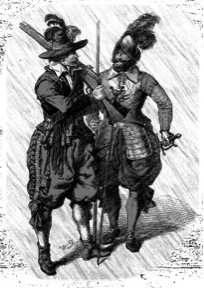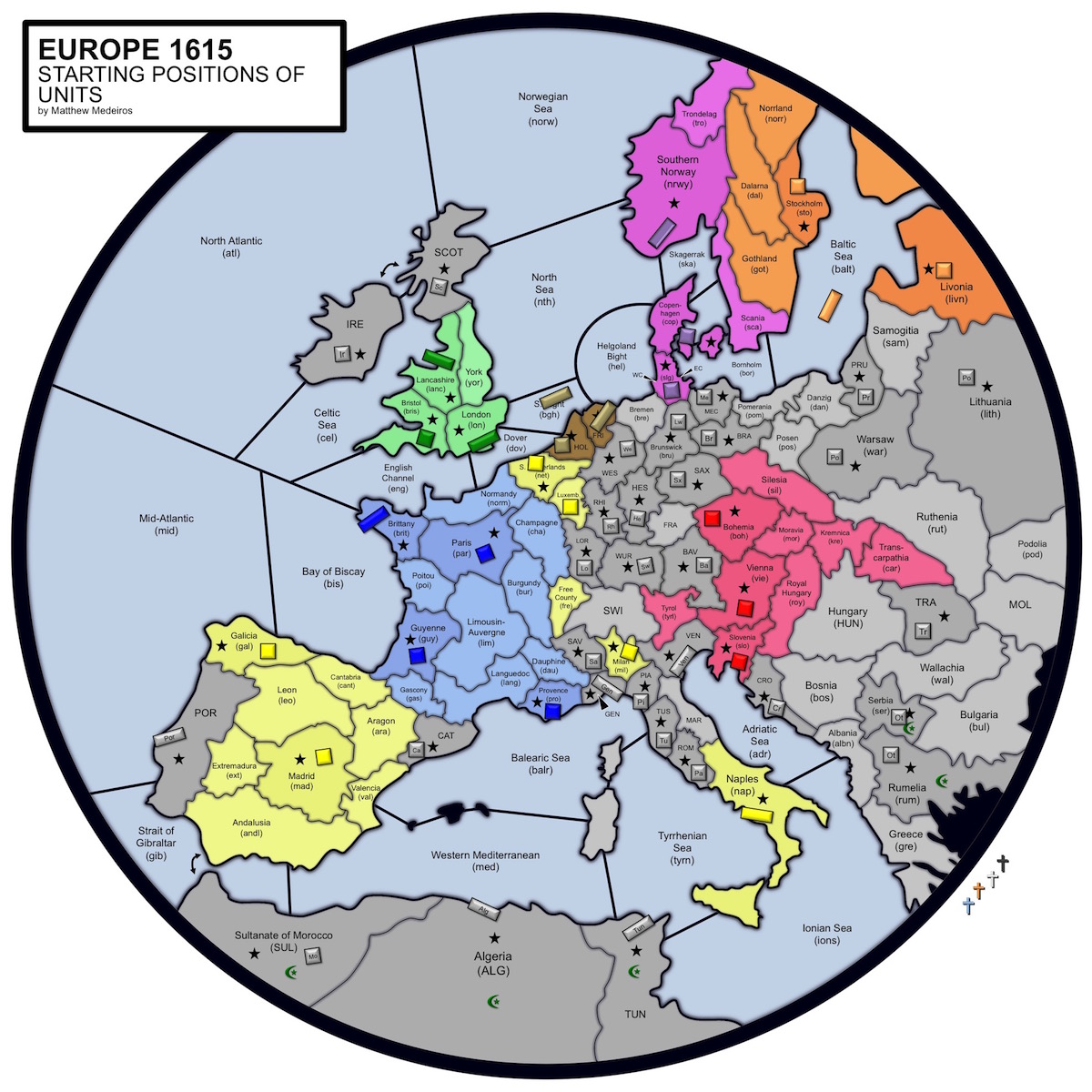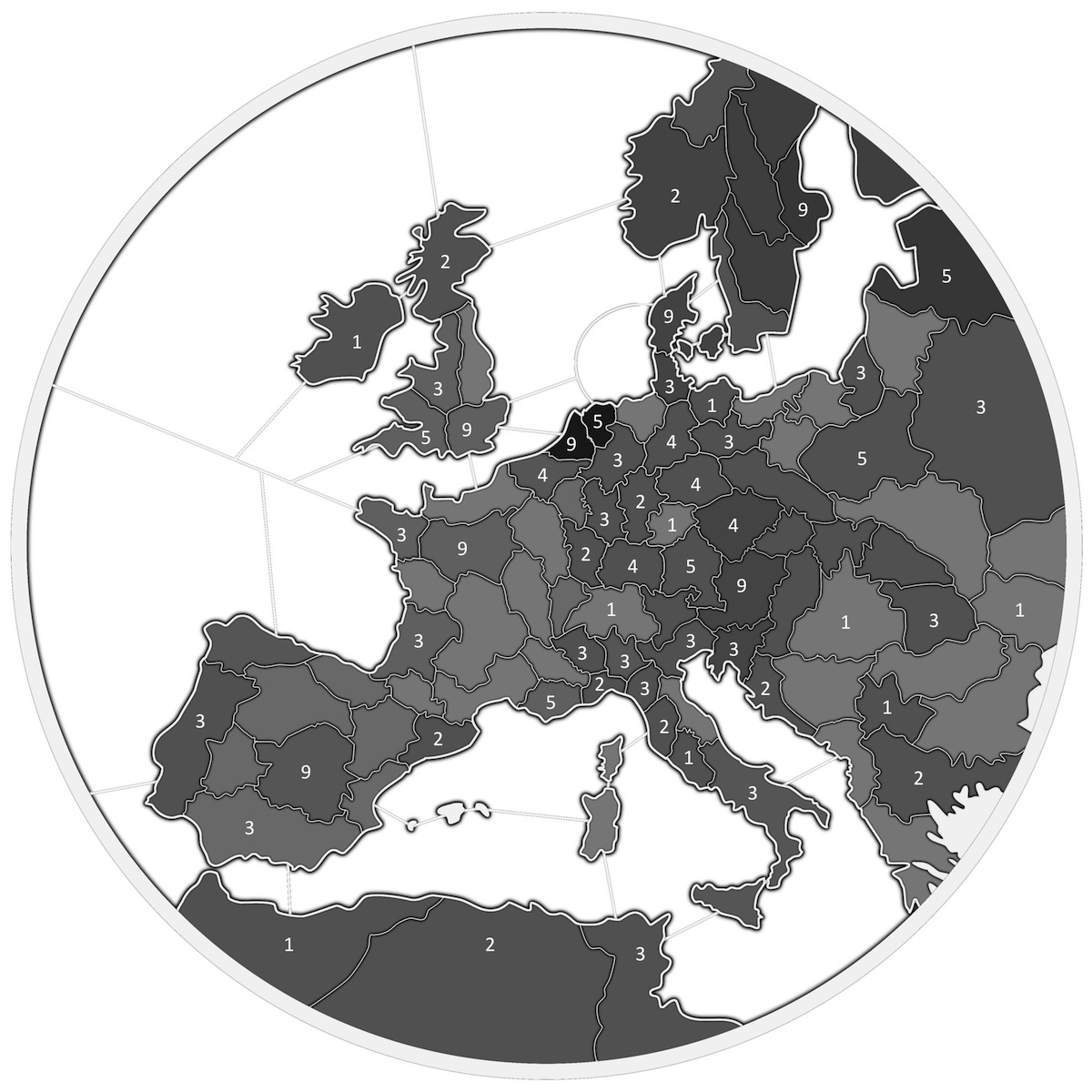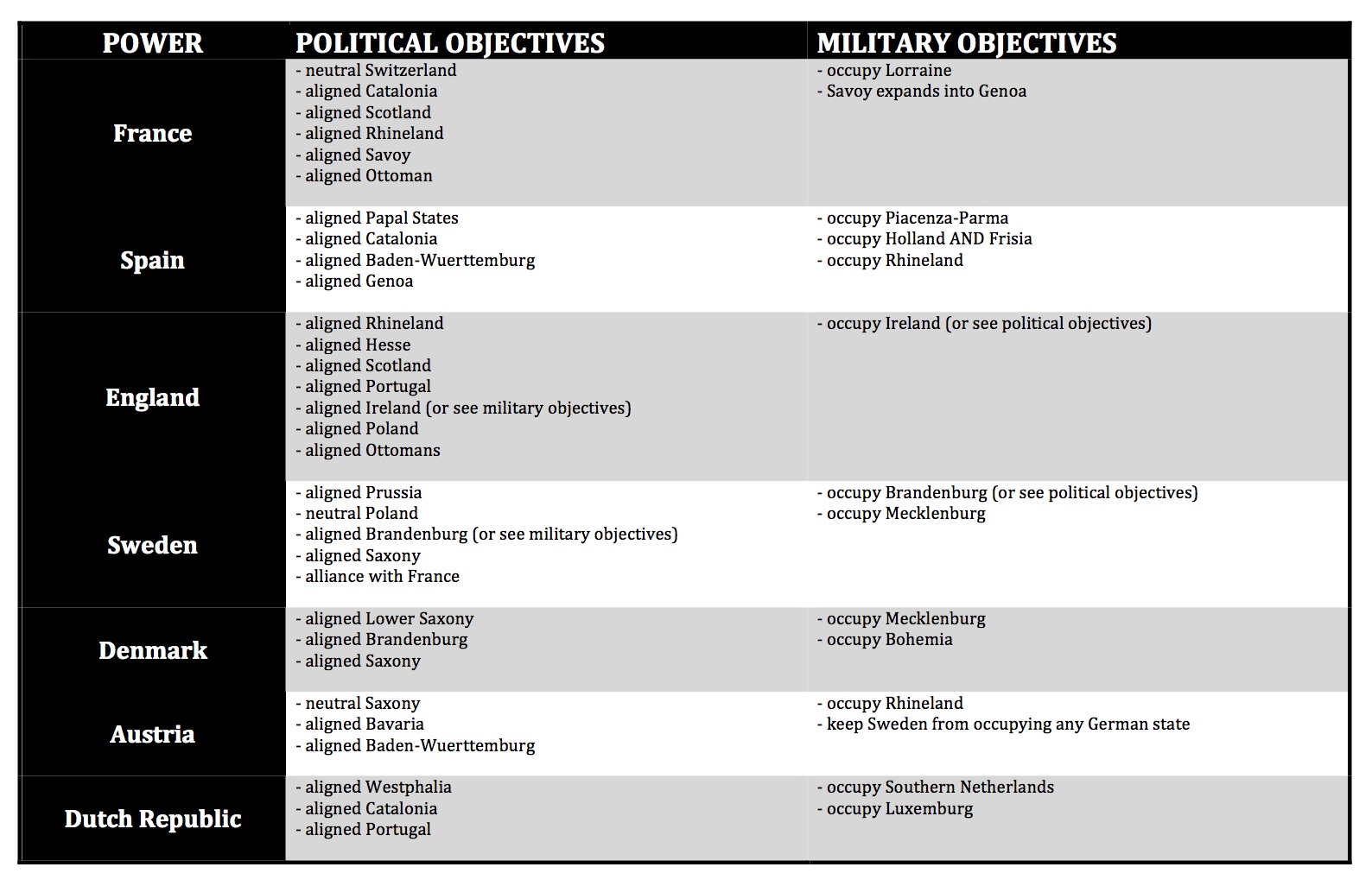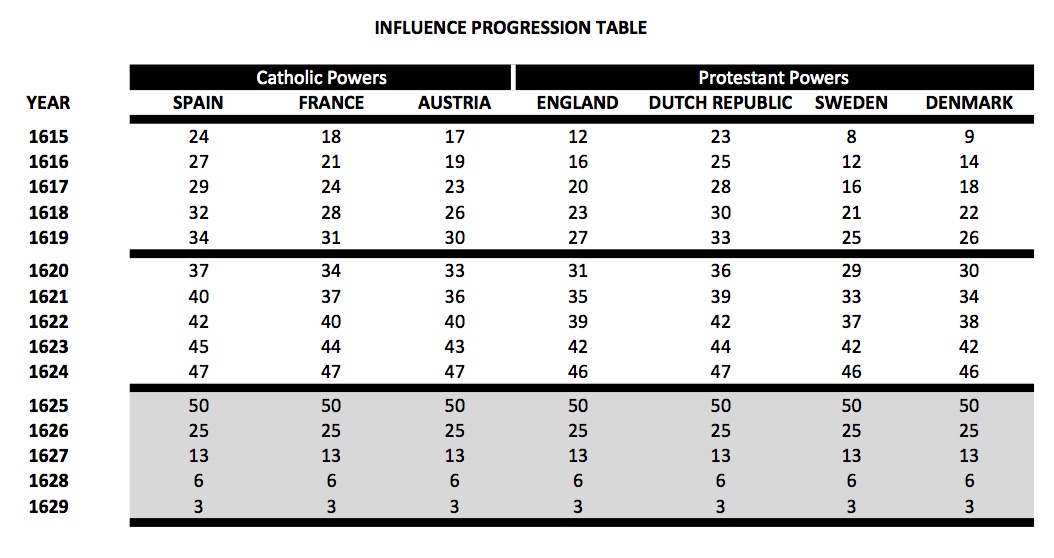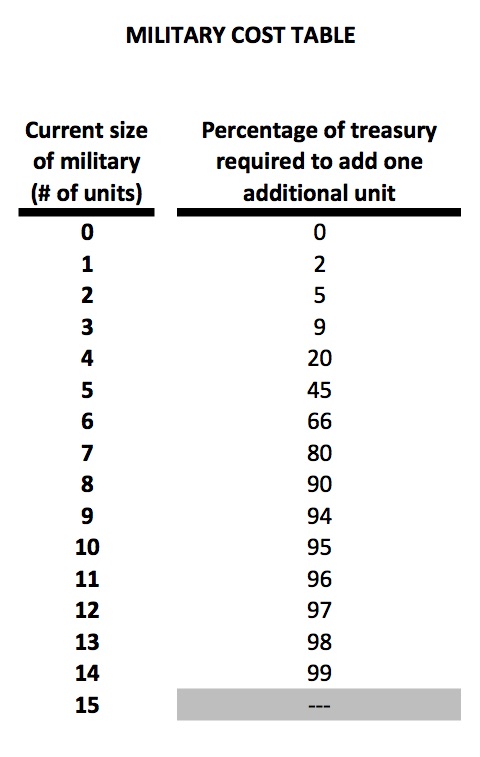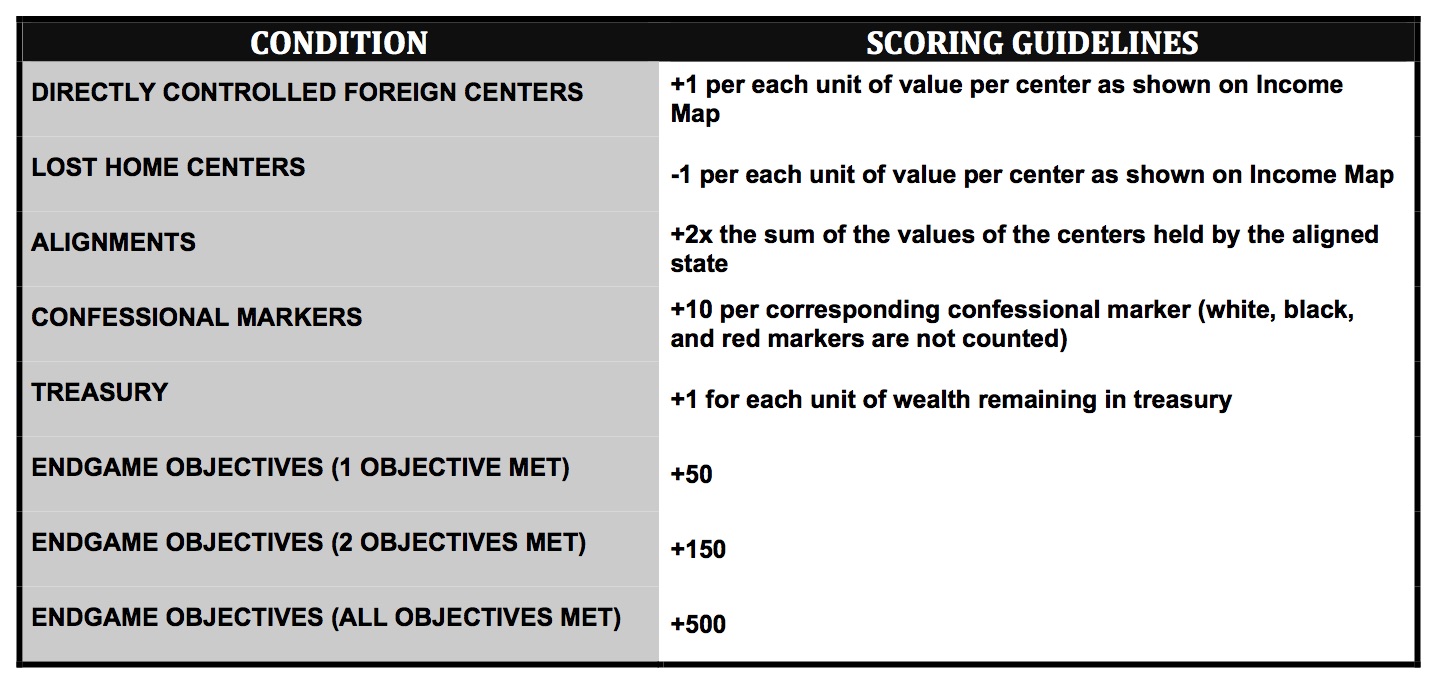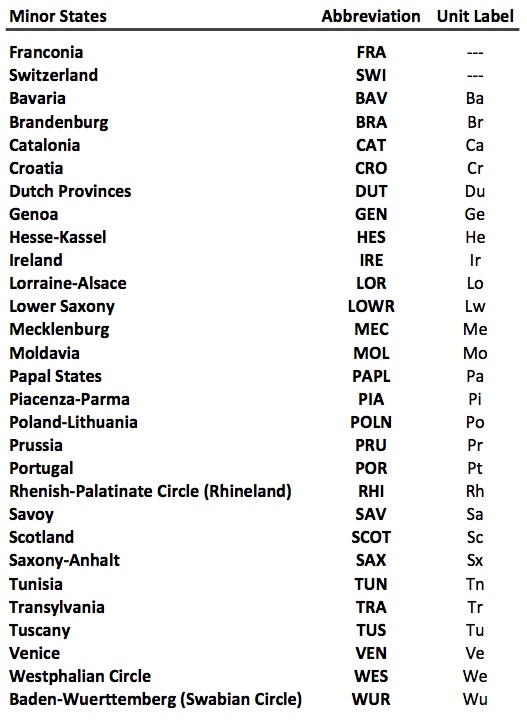Difference between revisions of "Europe 1615: Prelude to War"
| Line 188: | Line 188: | ||
=TABLES AND MAPS= | =TABLES AND MAPS= | ||
| − | Europe 1615 Map and Starting Positions | + | ==Europe 1615 Map and Starting Positions== |
[[Image:map_v2015-1.jpg]] | [[Image:map_v2015-1.jpg]] | ||
| + | |||
| + | ==Income Map== | ||
[[Image:INCOME-MAP_v2015-1.jpg]] | [[Image:INCOME-MAP_v2015-1.jpg]] | ||
| + | |||
| + | ==Objectives Table== | ||
[[Image:OBJECTIVES-TABLE_v2015-1.jpg]] | [[Image:OBJECTIVES-TABLE_v2015-1.jpg]] | ||
| + | |||
| + | ==Influence Progression Table== | ||
[[Image:INFLUENCE-TABLE_v2015-1.jpg]] | [[Image:INFLUENCE-TABLE_v2015-1.jpg]] | ||
| + | |||
| + | ==Military Cost Table== | ||
[[Image:MILITARY-TABLE_v2015-1.jpg]] | [[Image:MILITARY-TABLE_v2015-1.jpg]] | ||
| + | |||
| + | ==Scoring Guidelines== | ||
[[Image:SCORING-TABLE_v2015-1.jpg]] | [[Image:SCORING-TABLE_v2015-1.jpg]] | ||
| + | |||
| + | ==List of Pliant Minor States== | ||
[[Image:STATES_v2015-1.jpg]] | [[Image:STATES_v2015-1.jpg]] | ||
Revision as of 17:13, 30 August 2015
EUROPE 1615: VERSION 3
A DIPLOMACY VARIANT
by Matthew Medeiros
INTRODUCTION
Europe 1615 is a Diplomacy variant that adopts the mechanics from Jim Dunnigan’s and Thomas N. Shaw’s diplomatic game Origins of World War 2 first published in 1971. Various aspects of Europe 1615 are also inspired by other Diplomacy variants such as Ambition and Empire, Classic Payola, Machiavelli, and Formal Diplomacy. In Europe 1615, a player represents one of seven European powers of the early 17th century: Austria, Sweden, Denmark, Spain, France, Dutch Republic, or England. (Poland and the Ottomans are excluded as playable powers in this particular version of the game.) Europe 1615 attempts to simulate the political and religious struggles of the Protestant and Catholic powers, focusing on the years leading up to and beyond the opening of the Thirty Years War, in 1618. Players compete over political and religious control of minor German and Italian states, and other states peripheral to the German theatre of conflict. Player with the most points assessed at the end of the game takes victory. Europe 1615 utilizes the standard rules from 5th Edition Diplomacy with noted differences explained below.
PHASES OF THE GAME
A game year in Europe 1615 is divided into the following phases: 1- Spring Movement and Retreat Phase 2- Summer Movement and Retreat Phase 3- Fall Movement and Retreat Phase 4- Winter Adjustment Phase 5- Winter Income and Build Phase
INFLUENCE AND PLACEMENT
Each year Influence Points (INFs) are allocated to the powers as shown in the Influence Progression Table. Players distribute their INFs to the independent pliant minor states (see List of Minor States). Players should use all INFs available for the year and may not save unused INFs for the following year. Players may not distribute more INFs than available for the year. Players may not lend out INFs or remove INFs from a state once placed. INFs can be purchased, and this is done during the Winter Income and Build Phase.
To place INFs in a particular minor state, the player must submit an order in the following syntax:
number of INFs: [minor state]
SANCTIONS
Enforced sanctions: Protestant restrictions: Protestant powers cannot place INFs in the Papal States and Bavaria. Catholic restrictions: Catholics powers cannot place INFs to the Rhineland. Kejserkrigen: Beginning in 1625, only Denmark can submit INFs to Lower Saxony. Bethlen's intervention: Beginning in 1619, deployment of INFs to Transylvania (TRA) is solely permitted to the Protestant powers. Polish-Swedish rivalry: Only in the first year, Sweden is restricted from deploying INFs to Poland. Maghreb states: These states cannot be influenced at the start of the game. These states come into play after the Ottomans make first successful move. Then each state follows in sequence. Tunisia first can be influenced and moved, and once Tunisia moves successfully, Algeria then can be influenced, and then followed by Morocco.
Optional sanctions: Huguenot revolt: Beginning in 1621, Guyenne (GUY) secedes from France. Only Protestant powers are allowed to deploy INFs to the newly formed pliant state. Bohemian revolt: Beginning in 1618, Bohemia (BOH) secedes from Austria. Only Protestant powers are allowed to deploy INFs to the newly formed state.
THE DIPLOMATIC ATTACK
A diplomatic attack is when a player selects one state where he/she has deployed or will be deploying INFs and then directs a "political" attack against another player/power that also has INFs invested there. The diplomatic attack is ordered along with the placement of INFs. Each player is allowed to submit only one diplomatic attack order per Movement and Retreat Phase. The order should indicate the minor state of interest and the target (opponent) of the attack. Typical syntax for the order of the diplomatic attack:
[minor state] > [power]
Placement of INFs is determined first before diplomatic attacks are resolved. Diplomatic attacks are resolved by a MUTUAL REDUCTION. In the attack, the power with the lesser number of INFs placed removes all INFs and the power with larger number of INFs placed loses equal amount. If multiple attacks are ordered within a minor state, then the sequence of attacks is resolved based on the following: 1st- Sweden, 2nd- Denmark, 3rd- England, 4th- Dutch Republic, 5th- Austria, 6th- France, and 7th- Spain.
ALIGNMENTS
After diplomatic attacks are resolved, the referee will report to the players the statuses of the minor states, presented in a table, as well as in color-coding on the map. A minor state without INFs is considered unaligned (grey-colored). Unaligned states are passable during a Movement and Retreat Phase. If a power holds minimally 50% of all INFs placed in the minor state, then the minor state is considered aligned to the power, and passable or impassable depending on the declarations that have been made. The minor state will then follow any order submitted to the state’s unit by the power it is aligned to.
NEUTRALITY
For two or more powers equally invested in a minor state, the minor state will be marked as neutral (white-colored). Or if 3 or more powers are invested in a minor state, and no power holds the required 50% for an alignment, then the state is also considered neutral. Neutral states are impassable during any Movement and Retreat Phase.
CONFESSIONAL MARKERS
If Protestant powers solely hold the INFs in a minor state then a Protestant confessional marker (orange-colored cross) can be placed in the state. If Catholic powers solely hold the INFs in a minor state then a Catholic confessional marker (blue-colored cross) can be placed on the state. If both Protestant and Catholic powers hold INFs in a minor state, then a confessional marker is placed only when one confession holds twice the INFs over the other. Papal States will begin the game with a Catholic confessional marker. A state carrying a confessional marker that is captured by a unit matching the confession is replaced with a white-colored marker. If the state has an opposing confessional marker to the occupational unit then a religious rebellion will be in effect, and a red-colored cross is placed.
SPECIFIC RULES REGARDING MINOR STATES
(1) Units of minor states are automatically disbanded if dislodged.
(2) A power cannot dislodge or support the dislodgment of an aligned minor state's unit, even if that dislodgment is unexpected. An attack by a power on an aligned minor unit does not cut support.
(3) The capture of a minor state's home center leads to the disbanding of all its units, and the relinquishing of control of any foreign centers/states during the Winter Adjustment Phase.
DECLARATIONS AND MOVEMENT
Declarations allow players to declare war, announce alliances, or end war. During any Movement or Retreat Phase no power or aligned minor states of that power can move into the territorial domains of an opponent power and its aligned states unless a declaration of war is made or an alliance is established. All declarations must be made openly during a phase and recorded in the adjudication for that phase. The declaration then becomes effective during the subsequent Movement and Retreat Phase. Declarations made during the Fall Movement and Retreat Phase do not come into effect during the coming Winter Adjustment Phase or Winter Income and Build Phase; they come into effect during coming Spring Movement and Retreat Phase in the following year.
Declaration of war: Declaration of war with another player may be announced during a phase, and becomes effective in the following Movement and Retreat Phase. Declaration of war is made against an opposing power AND its aligned states. Therefore, if a power wishes to attack an aligned minor state, whether directly or with an aligned minor unit, it must declare war on the power that the minor state is aligned to. If no declaration of war has been made, this is what is allowed: (1) Declaration of war is not required for a power or minor state to move against an unaligned minor state. (2) Just like in standard Diplomacy where a dislodged unit will still cause a standoff, in Europe 1615, a unit ordered into a foreign province without a declaration of war cannot move into the province, but may cause a standoff in the province. If no standoff occurs in the province, then a unit may retreat to the province. (3) Continuing with rule (2), a unit may support holds, convoy, or support movement into a province without a declaration of war.
Alliances: Declaration of an alliance with another player may be announced during a phase, and becomes effective in the following Movement and Retreat Phase. All potential members involved in the alliance must make the declaration for it to be official. Alliances allow the following: (1) A member of an alliance can move freely through the territories and centers of another ally; this includes aligned minor states of the member. A member of an alliance cannot dislodge or support the dislodgment of an ally’s unit, even if that dislodgment is unexpected. An attack by a power on an ally does not cut support. This also applies to minor states aligned with the ally. Allies cannot capture each other's centers or the centers of their aligned states, but may occupy those centers (see Occupation by Proxy). Breaking from an alliance can be initiated by any member of the alliance and declared during one Movement and Retreat Phase and made effective in a subsequent Movement and Retreat Phase.
Declaration of surrender: A player may surrender to an opposing power to save his position in the game. Surrender comes at a price. The victorious power can levy an indemnity against the surrendering power. This would be an agreed upon sum between the two parties, but the indemnity cannot plunge the surrendering power below 25 units of wealth. The indemnity should be divided equally between members of a victorious alliance.
Armistice: Players at war may use any phase to announce an armistice to officially end hostilities.
SECURING CONTROL OF A CAPTURED FOREIGN CENTER
For a power or a minor state to maintain control of a foreign province, it must maintain occupation of the province. If the province is no longer occupied at the end of the Winter Adjustment Phase, it immediately reverts back to its independent status. A controlled minor state cannot be influence by any power; however, all INFs invested in the state are held in suspension, not removed or altered. A power may relinquish control of a state/province to reestablish its independent pliant status by simply removing its occupational unit. When a state is released, the INFs that were held in suspension are put back into effect, and status reestablished.
Since a power or minor needs to maintain occupation of a foreign province to maintain control, how can a power/minor maintain control if the occupational unit needs to move? Two acceptable methods allowed:
Occupation by proxy: If you can substitute an aligned minor unit or an ally’s unit for your occupational unit in a foreign province, then you may still maintain control of the province.
Transferring control: During the Fall Movement and Retreat Phase, if there is occupation by proxy, you may transfer control of the province to the minor or another power that occupies it. This is done by making a public announcement, and takes effect in the Winter.
RELIGIOUS REBELLION
If a controlled center carries an opposing confessional marker to the occupational force then the state will be considered in revolt (confessional marker replaced with red-colored marker). A revolting state does not allow an occupying power to collect income on the center. The revolt quells after a given number of Movement and Retreat Phases. This determined from the value of the center or province. For example, if the Dutch secure control of the Southern Netherlands (NET) in the Winter of 1620, the state is in revolt (Protestant power capturing a Catholic state). NET has a value of 4; therefore, the revolt will be in effect during the Spring, Summer, and Fall of 1621 and Spring of 1622. The revolt ends in the Summer of 1622, at which time the red-colored marker is replaced with a black-colored marker. The Dutch will be unable to collect income on NET in Winter of 1620 and 1621.
Note: Religious rebellion does not apply should a Protestant power capture Bohemia or Guyenne. Immediately place a black-colored marker when the capture occurs.
COMBAT ATTRITION RULE (ARMY UNITS ONLY)
When a power’s army unit is forced to retreat, it gains an attrition mark. Attrition prevents the unit from retreating a second time. If forced to retreat a second time, it is automatically disbanded. Attrition is relieved on all units at the Winter Adjustment Phase.
CREATING A NEW PLIANT MINOR STATE
When a home center is captured by a foreign power or minor state, and later that control is relinquished, then the province becomes a newly formed pliant minor state.
ADDING A UNIT FOR A POWER
During the Winter Income and Build Phase players may “purchase” units base on the Military Cost Table. The cost to add one additional unit is equal to a percentage of the treasury based on the current size of the military. The power must have an unoccupied home center for a build to be allowed. The number of units that may be added is limited by the treasury and unoccupied home centers. To calculate the cost to add more than 1 unit during this phase, the player must assess the cost of one additional unit after one unit has been purchased. No power can have more than 15 units on the board. Example: France wishes to add two units during the Winter Income and Build Phase. At a military size of 5 units, it will cost 45% of the treasury to add one more unit. To add the second unit, France considers the new size of the military at 6 units. From 6 to 7 units, it would cost 66% of the remaining treasury after the first unit was purchased, provided that the purchase does not plunge France below the minimum of 25 units of wealth in the treasury. (If that is the case, then France cannot build the second unit.)
ADDING A UNIT FOR A MINOR STATE
A minor state will automatically add a unit if it controls a foreign center. With minor states, number of units that it may have is directly equal to number of controlled centers. During the Winter Adjustment Phase if a minor state has more units than controlled centers it must disband units until the number of unit equals number of centers. If the minor state is aligned, the aligned power must dictate which units to disband. If not aligned, then units are disbanded beginning with the unit furthest from the state.
INCOME PHASE
Each player begins with a treasury with 50 units of wealth (players may settle on a particular unit name for the period such as millions of ducats, millions of florins, or millions of talers). A treasury can never fall below 25 units. When the Winter Income and Build Phase occurs, all players receive income (or tribute) from home centers and controlled centers (or provinces such as Switzerland that does not have a center). A home center under foreign occupation is in revolt if the occupier’s confession is opposing, and thus, does not provide income unit the revolt is quelled. For a home center or any controlled centers, the power receives funds equal to the value of the center as shown on the Income Map. Islamic states do not provide income. For other restrictions see section on Religious Rebellion.
OBJECTIVES
At the final scoring phase, players receive points for meeting specific objectives. Each power has a set of objectives listed in the Political and Military Objectives Table. Before the start of the game, players should select three objectives for their power, and submit this to the referee. The referee will compile a list of submitted objectives for each power and will reveal this list to all players.
ELIMINATION
Power that is no longer in control of all its home centers is considered eliminated, irrespective of controlled foreign centers. When a power is eliminated, all units are disbanded at the Winter Adjustment Phase, and the foreign centers that are held are liberated restoring them as pliant minor states and to their previously-suspended status. INFs from the eliminated power are removed from all minor states where the power has invested, and the statuses of these minor states reevaluated.
MID-GAME AND FINAL SCORING
Game ends at the opening of 1630. Referee may score players mid-game, say, 1625, so that they can gauge their progress. On the year that the game ends, the referee tallies the final score based on the guidelines shown in the Scoring Guide. Player with the highest score wins the game. In case of ties, players may agree to extend the game to break the tie, or call a draw.
NOTES ABOUT THE BOARD
Large states. Several minor states are composed of smaller provinces as shown below. When a political status is established for these states, all provinces of the state are identified as aligned or neutral. Lower Saxony (LOWR) = Bremen & Brunswick-Lunenburg Poland (POLN) = Danzig, Posen, Warsaw, Galicia, Samogitia, and Lithuania Papal State (PAPL) = Marches and Rome Brandenburg (BRA) = Berlin and Pomerania Ottoman Empire (OTT) = Rumelia, Greece, Bulgaria, Serbia, Albania, Bosnia, Muntenia, and Moldavia
Costal province. Schleswig-Holstein (SLG) has two coasts. Moving from Copenhagen to SLG requires that the coast be specified. SLG (EC) – SLG (WC) or visa versa is not a legal move.
Starting positions. Both the Dutch and the Swedes have units that do not start on centers. Spain starts with an extra unit in Luxemburg.
PLAY-TESTERS
My gratitude to the following individuals for their time in play-testing of this variant:
Christian Schanner Shane Cagney Poul Hurup Lund-Andersen Matthew Kelly Michael Walters Ewoud Wiering Chris Lee Chun Wang Lau Andrew Port Mark Utterback Max Victory Steven Caponigri Aaron Havas Greg Bim-Merle
